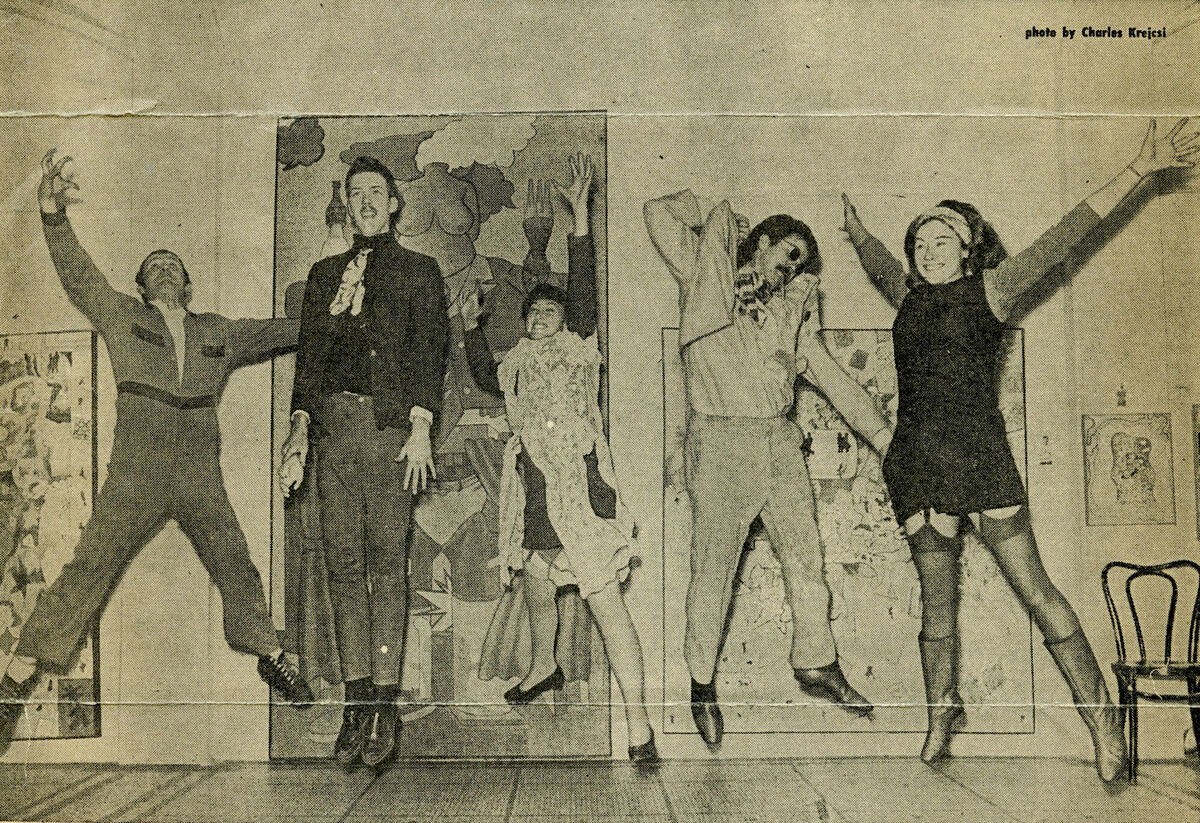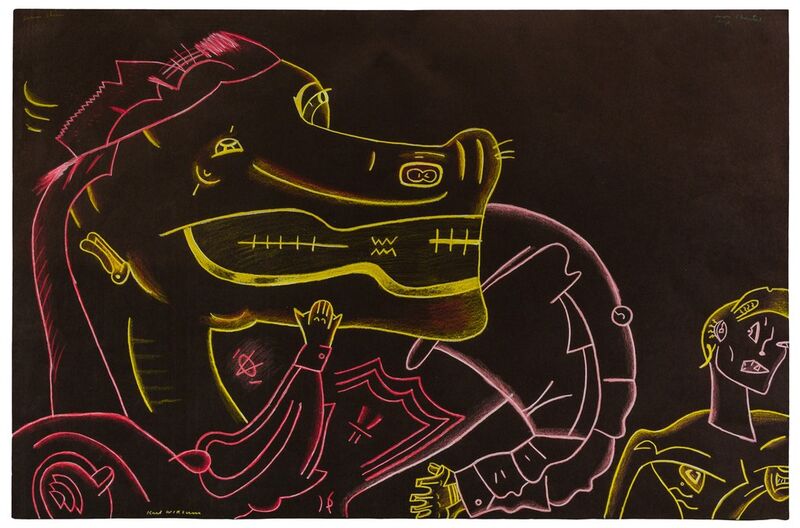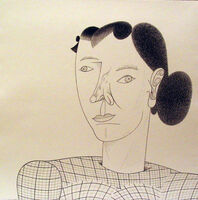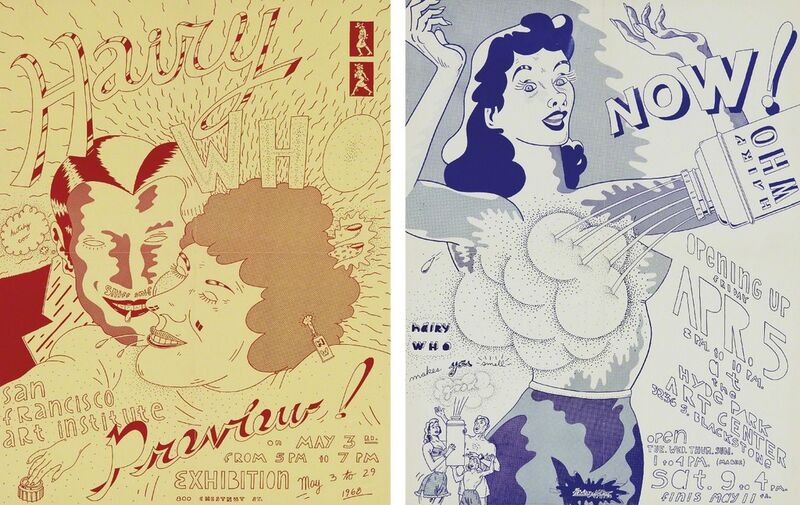Edmée Lepercq
Sep 8, 2020

Portrait of Hairy Who by by Charles Krejcsi for the Chicago Daily News. Courtesy of Pentimenti Productions.
If New York Pop art was considered cool, Chicago’s was hot, embodied in the mid-1960s by six recent graduates from the School of the Art Institute of Chicago who exhibited together under the moniker “the Hairy Who.” While Andy Warhol and Roy Lichtenstein treated mass consumerism and popular culture with irony and distance, the Hairy Who were interested in the emotional charge of such imagery. One was personal, the other aloof.
The Hairy Who were united by their education, their sense of humor, their craftsmanship, and their knowledge of art history. Their sources were as eclectic and far-ranging as Art Brut, Surrealism, sale catalogues, bodybuilders, and medical illustrations. Today, the Hairy Who are renowned for their hallucinatory representations of the body, which shows it fragmented, elongated, and exaggerated. Their works often depict mutilations and skin diseases, which sit in stark contrast with their otherwise cheerful aesthetic. The dissonance perfectly captures the tensions between the relentlessly upbeat fantasy world of American consumerism and the political upheaval of the Vietnam War and the civil rights movement during the 1960s. Chicago itself was an epicenter of racial tension throughout the 1960s following desegregation attempts by Dr. Martin Luther King Jr. and others.
Though the collective exhibited together for just three years, from 1966 to 1969, they drew national and international attention and catalyzed the broader Chicago Imagist
movement, which extended into the 1980s. Rather than a series of group shows, their exhibitions challenged traditional modes of installation with artists covering gallery walls with flowery linoleum and hanging oversized price tags on paintings and drawings. Each exhibition came with a comic book–style publication—a dig at stuffy exhibition catalogues—as well as buttons and posters. It was a far cry from the white cube.
So, who were the six members of the Hairy Who?
Karl Wirsum
View Slideshow
6 Images

Karl Wirsum inadvertently gave the group its name when he walked into a meeting where the other members were talking about the art critic Harry Bouras. Wirsum asked, “Harry who? Who is this guy?” They changed “Harry” to “Hairy,” and the name stuck. Wirsum’s work usually consists of a single, central, confrontational figure set against a monochromatic background. His figures are never fully human, but rather a humanoid mash-up of robots, aliens, and totemic forms. One of his inspirations is the symmetry of Mayan and Aztec stone carvings, which he came upon during a 1961 trip to Mexico with the artist
Ed Paschke
. Another is the boldness and brashness of Chicago’s jazz and blues music. Wirsum even made portraits of musicians like Screamin’ Jay Hawkins and Junior “Messin’ with the Kid” Wells, channeling the intensity of their performances into his work. In the 1970s, Wirsum’s characters burst into three dimensions. He began making sculptures—brightly painted figures of boxers, animal masks, and skulls reminiscent of the Mexican holiday Dia de los Muertos (or “Day of the Dead”). Like his drawings, they emanate a sense of unbridled energy; a cacophonous, rapturous mix of joy or insanity.
Jim Nutt


Jim Nutt
American, b. 1938
FollowJim Nutt was a member of the Imagist and Hairy Who groups centered in Chicago in the 1960s and ‘70s. His graphic, vividly sexual, and psychological work was …
Jim Nutt
View Slideshow
6 Images

Advertisement
In Jim Nutt’s work, the unruliness of the human form is front and center—pimples erupt, sweat splashes off, and hairs sprout like a crop of microgreens. Yet the vulgarity in his images, from their gory details to their locker-room humor, is always offset by the artist’s technical prowess. Every one of Nutt’s compositions is planned with the utmost care. For example, in his formative early paintings on Plexiglas, Nutt worked out all of his ideas, shapes, and forms on a sheet of paper the same size as the final work. He then taped the paper onto one side of the Plexiglas and, looking through its transparent surface, painted the lines and colors of the sketch on the other side. By the 1990s, Nutt’s cartoonish early work would move toward Renaissance-esque portraiture. Painted on canvas or wood, blackened noses, tumorous growths, and skin diseases afflict the faces of men and women with intelligent eyes and fanciful updos. Each sitter features the pose and demeanor of bygone aristocrats, yet suffers illnesses worthy of any medical journal, all depicted in the subtlest of hues.
Suellen Rocca
View Slideshow
6 Images

Suellen Rocca has described her own work as a form of picture writing, akin to hieroglyphs. Her paintings are composed of repeated, gendered motifs; inspired by cultural icons of beauty and romance in mass media, handbags, lipsticks, and palm trees speak to popular culture through a personal lens. Rocca was fascinated by how a single palm tree can encompass a vision of paradise, or how a diamond ring symbolizes true love. In her earlier work, she divided the picture plane into panels evocative of comic strips and sale catalogues, creating a pastel-hued periodic table of squiggly-lined feminine symbols. After an artistic hiatus from 1972 to 1981, Rocca began making paintings with a darker emotional weather, which she called “more internal.” They often feature a central female figure surrounded by a selection of floating commercial objects. As with her earlier work, these paintings offer themselves up as interpretive lists and diagrams.
Jim Falconer
James “Jim” Falconer’s drawings and paintings from 1966 to 1968 are full of images from pop culture rendered in a floppy, wiggly style and hallucogenic colors. Drawing influence from German Expressionism, Surrealism, and artists like Peter Saul and H.C. Westermann
, Falconer also found inspiration in ordinary, industrial things like vintage linoleum and hand-painted signs. One body of work features silkscreens of bright, organic, abstract forms mounted onto linoleum flooring decorated with dusty motifs of rose bouquets. Set into red or blue frames the artist made himself, a price tag sometimes hangs off the work, its colors complementing the image.
While every member of the Hairy Who wrestled with the sociopolitical tensions of the 1960s, Falconer was perhaps the most overtly political. Having co-founded the activist group Artists Against the War in Vietnam with Dominick di Meo, Robert Donley, and Donald Main in 1969, Falconer moved to New York City in 1970, where he abandoned visual art to work in film, photography, and music for the next 35 years. He returned to Chicago in the early 2000s and has since been making abstract paintings that continue his early work among the Hairy Who.
No comments:
Post a Comment